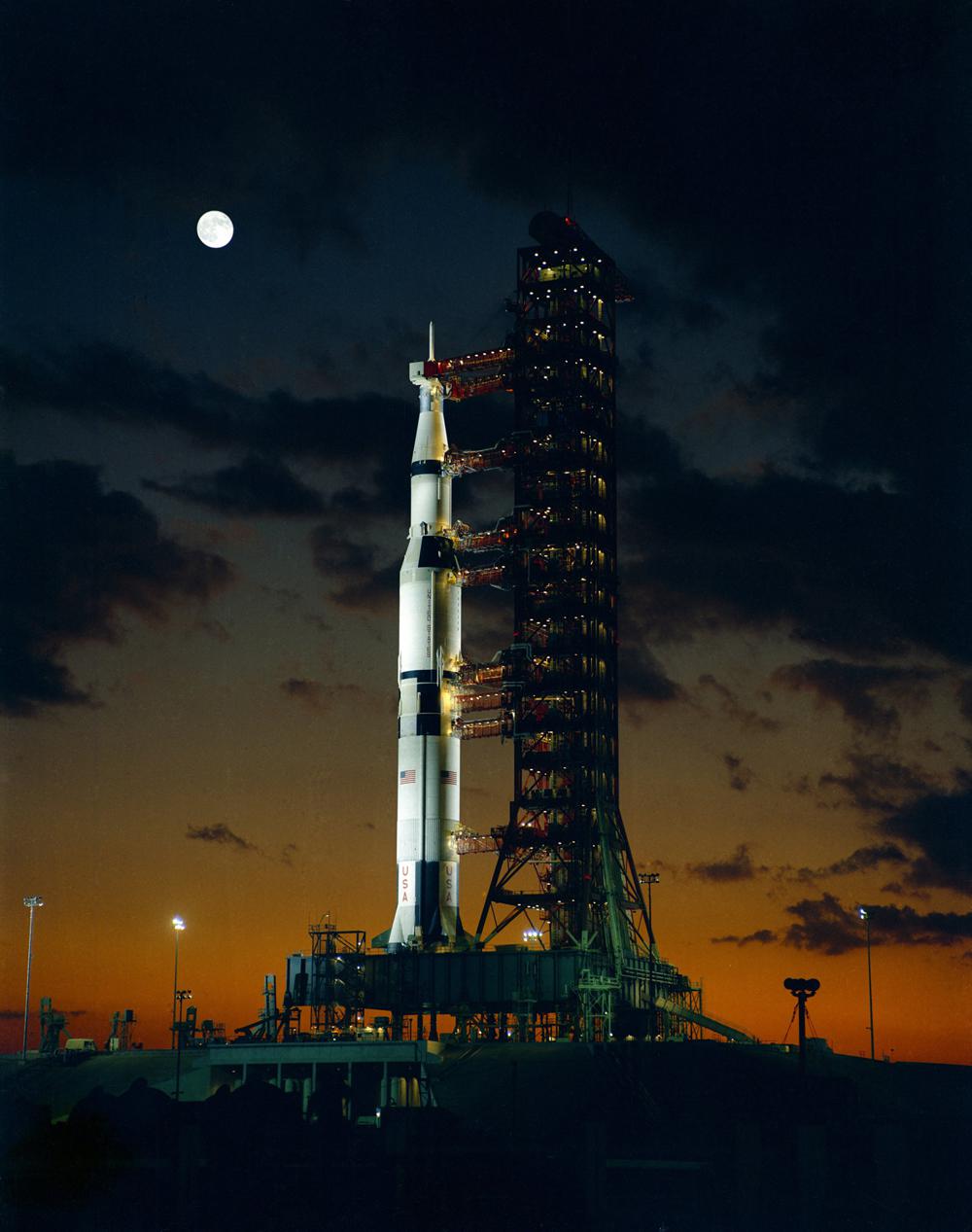NASA's Mighty Saturn V Moon Rocket: 10 Surprising Facts | Space
Introduction
NASANASA's incredible Saturn V rocket propelled dozens of humans toward Earth's moon. The rocket's first flight, for the Apollo 4 mission, took place 50 years ago, on Nov. 9, 1967. The rocket passed its first integrated test with flying colors and was cleared to send humans to the moon after only one more test flight. The Apollo 11 mission, which was launched to space on a Saturn V, safely landed two people on the moon in 1969. Here are 10 surprising facts about the Saturn V rocket and its place in history, including how it stacks up to NASA's new Space Launch System (SLS), the next NASA rocket intended to bring people to the moon.
It burned more fuel in 1 second than Lindbergh used to cross the Atlantic
NASA; NY Daily News Archive via GettyThe crew of Apollo 8, the first humans to circle the moon, received a special visit from Charles Lindbergh prior to the mission launch in December 1968, according to the Robert Zimmerman book "Genesis: The Story of Apollo 8" (Dell, 1998). Lindbergh was the first pilot to cross the Atlantic Ocean solo, which he did in 1927 in his aircraft the Spirit of St. Louis, which is on display today at the Smithsonian National Air and Space Museum in Washington, D.C. Lindbergh and the astronauts, all hailing from aviation backgrounds, talked about fuel consumption. The first stage of the Saturn V rocket, using five F-1 rocket engines, produced 7.5 million lbs. (3.4 million kilograms) of thrust and was used during launch for about 2 minutes. It gobbled up 20 tons (40,000 pounds) of fuel per second. Lindbergh's little aircraft used 450 lbs. of fuel to get across the Atlantic. Thus, the men estimated that in just a tenth of a second, the Saturn V would burn 10 times the amount of fuel Lindbergh used for his entire trip.

It's flight profile is similar to NASA's SLS
NASANASA has similar goals for its next-generation rocket, the Space Launch System (SLS), as the agency did for the Saturn V. Both rockets are intended to get people to the moon, although the SLS may also be used to send people to deep-space destinations like Mars. So, although more than half a century of design separates the two rockets, they have similar mission profiles. Both rockets have an escape launch system (which is used in aborts during launch), a crew module and a service module. Both rockets use several stages to bring astronauts into orbit, including an upper stage that is used to help the astronauts break free of Earth orbit and push them toward the moon; this maneuver is called a "trans-lunar injection."
It went from paper design to flight in 6 years
Marshall Space Flight Center/NASARocketeering is a notoriously hard business, and it was especially difficult in the 1960s. Formal development on the Saturn V began in January 1961; it was then called the C-5 rocket. The rocket's development was led by Wernher von Braun, a German-born engineer who wanted to test each part of the rocket separately. But NASA was planning to land humans on the moon before the end of the decade, so George Mueller — NASA's director of the office of manned space flight — ordered a test of the entire rocket at once. Though Von Braun was reluctant, the Saturn V made its first uncrewed flight on Nov. 9, 1967; the rocket met all major goals. A second test of the Saturn V, for the Apollo 6 mission, took place in April 1968. Just a few months later, in December 1968, another Saturn V rocket took the Apollo 8 crew into space on the first stage of their moon mission. The first moon landing took place on schedule, in July 1969.
NASA's Vehicle Assembly Building was made for the Saturn V
Frank Michaux/NASAThe Vehicle Assembly Building (VAB) at the Kennedy Space Center is a remarkable piece of history. Finished in 1966, the VAB spans 348,480 feet (32,374 meters), stands 525 feet (160 m) tall and is 518 feet (158 m) wide. This huge building was originally intended to house the Saturn V during final assembly before launch; after that, the rocket would be towed about 4 miles (6.4 kilometers) to one of two launchpads, either 39-A or 39-B. While the Apollo program stopped in the 1970s, its infrastructure remains useful. NASA's space shuttle missions used the VAB and launchpads between 1981 and 2011. NASA will also use this building for future missions with the Space Launch System (SLS) rocket.
It had 13 (mostly) successful missions
NASAWhile the Saturn V was a complex machine, the rocket had a remarkable safety record. The Saturn V successfully flew 13 times, including 10 times with people on board. While some of these launches had flaws, in almost every case, the Saturn V sent its cargo safely into orbit. However, the Skylab space station was severely damaged during a Saturn V launch — more on that in the next slide. Perhaps the most famous test of Saturn V's durability came during the launch of Apollo 12 in 1969, when lightning struck the vehicle a few moments after liftoff. Luckily, although the astronauts saw some strange warning lights from inside their spacecraft, there was no major damage, and they safely proceeded to a landing on the moon's Ocean of Storms.
It launched the Skylab space station
NASANASA's first space station, Skylab, was launched into orbit by a Saturn V in 1973. Unfortunately, the station wasn't in great shape, due to severe vibrations during launch and the subsequent deployment; one of the station's sunshades and one of its solar panels were lost, and its only remaining solar panel was jammed against the side of the station. Fixing the situation required the first crew of Skylab (called Skylab 2) to deploy a sunshade and unjam the panel while in orbit, with the help of ground controllers. (NASA engineer Jack Kinzler, who suggested the sunshade, received a NASA Distinguished Service Medal for his efforts.) Luckily, the collective efforts of the astronauts and NASA engineers saved Skylab and allowed three crews of three astronauts each to occupy the station in separate missions between 1973 and 1974.
You can see Saturn Vs in museums
Album/PrismaThe Saturn V rocket was intended to be disposable. Each rocket's mighty first stage, after hurling humans toward space, detached from the rest of the rocket and fell into the ocean. NASA intended to leave those spent rocket stages there, but Amazon founder Jeff Bezos (who also runs the spaceflight company Blue Origin) launched expeditions to recover the stages. "They are dissolving away in the saltwater. We should go get them and put them in a museum," Bezos said in August 2017, describing his thoughts when he launched the recovery initiative. He was successful; his mission recovered several pieces of Saturn V rockets at 3 miles (4.8 km) deep, including parts that were on the Apollo 11 mission. Some of these pieces are on display in museums. Unused complete Saturn V rockets are also on display at NASA's Johnson Space Center, NASA's Kennedy Space Center, and the U.S. Space & Rocket Center in Huntsville, Alabama.
You can build your own Saturn V rocket!
Whatsuptoday/Lego IdeasThe Saturn V is still inspiring generations of space explorers, even though its last launch took place 45 years ago, in 1972. On June 1, 2017, Lego released a model of the Saturn V rocket that consists of 1,969 toy bricks (meant to reference the year 1969, when humans first landed on the moon). The rocket was first proposed by two members of the public in 2014, through a program that lets fans propose new Lego sets. If building one rocket model is not enough, you might be able to hunt down other versions of the Saturn V. Some examples: Revell Inc. once sold a version of the Saturn V rocket that stood 4 feet (1.2 m) tall; there is a copy of the model at the Smithsonian National Air and Space Museum in Washington, D.C. Puzz 3D, when it was owned by Hasbro, released a 3D puzzle of the Saturn V rocket in the early 2000s.
Its first-stage engines were tested recently
MSFC/NASABeginning in 2013, NASA engineers working on the next-generation SLS rocket initiated a program to retest the F-1 engine from the Saturn's V first stage to gain better insight into how it was designed and how it worked. The new data would help those engineers in their quest to send humans back to the moon. The work on these components included hot-fire tests, 3D scanning and gas-generator testing. "Being able to hold the parts of this massive engine that once took us to the moon, restoring it, and then seeing it come back to life through hot firings and test data has been an amazing experience," Kate Estes, a NASA liquid-propulsion systems engineer, said in a NASA release in 2013.
Saturn V is taller than the Space Launch System
NASAWitnesses to Saturn V rocket launches described the incredible roar, something that even the space shuttle's rocket couldn't equal when it sent people aloft between 1981 and 2011. But spectators will soon have the chance to see the launch of another worthy moon-seeking rocket, the Space Launch System, whose first test launch is expected to happen around 2019. Like the Saturn V, SLS is expected to be capable of sending people to the moon and bringing them back. It's a little shorter than the Saturn V, standing at 320 feet (97.5 m) tall compared to the Saturn V's 363 feet (110 m). But SLS will produce 8.4 million lbs. (3.8 million kg) of thrust, surpassing the Saturn V's thrust of 7.5 million lbs. We can't wait to see the new rocket in action.
-
Latest
 3 Prayers To The Universe To Manifest What You Want - Co ...
3 Prayers To The Universe To Manifest What You Want - Co ...Your prayers to the universe never goes unanswered. The evidence for this is your life. The content of your prayers to the universe is no so much that which you ask for when you sit down and close you...
-
Next
 Why Deism Fails as a Philosophical Paradigm of the Universe
Why Deism Fails as a Philosophical Paradigm of the UniverseWhy Deism Fails as a Philosophical Paradigm of the Universeby Rich DeemIntroduction DeismDeists take pride in their reliance upon the knowledge and logic inherent in their worldview. Although these th...
Popular Articles
- Rocket Power (TV Series 1999–2004) - Rocket Power (TV Series ...
- technique - What is the definition of 'playing in the pocket ...
- "Pocket rockets," in poker Crossword Clue Answers, Crossword ...
- 5 Sex Toys Every Man Should Own, Use & Use Again - LA Weekly
- Pocket Holsters: 11 Options For Easy Everyday Carry (2021 ...
- What is Elton John's most successful song? (Celebrity Exclusive)
